|
Residencies - new spaces of creativity
Report from the panel Mobility and residencies for artists and curators of contemporary art
December 6, 2011
City Muesum Ljubljana
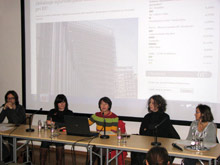 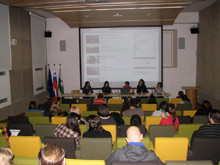
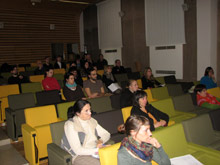 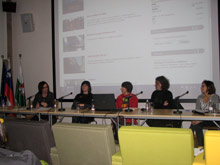
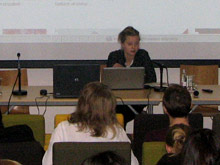 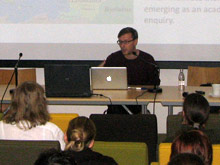
Artservis, one of the programmes of SCCA-Ljubljana, prepared a panel and workshop Mobility and residencies for artists and curators of contemporary art on the 6th of December 2011 in the City Museum Ljubljana. The event was prepared in the framework of the training programme for artists; On-AiR.
The conference was moderated by Marija Mojca Pungerčar, Artservis editor and artist, who pointed out that mobility has long been one of the priority themes of artistic production and cultural policy. Artservis is following this with its contents – open calls or advices in the Artservis manual, and specialized web content for mobility - Artist on a business trip. New web content follows the recommendations or information standards for mobility, which have been prepared from May 2011 by a group of experts at the headquarters of European Commission DG Education and Culture. Among them was also Dušan Dovč, a member of the Artservis editorial board. He addressed the audience during the panel at the conference and in particular the Ministry of Culture representatives, to establish a comprehensive system of support for the mobility of artists and cultural workers as soon as possible. Artservis is recognized as an example of good-practice in Slovenian and internationally.
After the introduction Marija Mojca Pungerčar gave the word to Nevenka Šivavec, Director of the International Centre of Graphic Arts (MGLC) in Ljubljana and a former colleague of the Institute Celeia Celje. Nevenka Šivavec pointed out that residential programmes are interdisciplinary and can link to culture with tourism or business. An open call for the residency in Celje includes a public presentation of work; selected artists are given a space and a fellowship. With guest artists and curators they have successfully put Celje on the map of residences and with artistic actions in the streets they moved art closer to those citizens that don’t visit galleries so often. In Celje they are planning another residency – the residency of Alma Karlin, which is offered to a broad public of researchers, anthropologists, artists and more. Nevenka Šivavec pointed out the problem that they failed to establish a network that would allow reciprocity. However, many artists return to Celje. And as Nevenka Šivavec says, she is most happy when she does not know about such returnees, because that is a sign that they have established a permanent and independent relationship with the environment of Celje.
Alenka Gregorič, head of the City Art Gallery Ljubljana and Gallery 001, presented a residency program in Tobacco 001 Cultural Centre. They started in April 2011 and already hosted four artists in two month residencies. They offer a scholarship, a place to work, housing, and - if possible - an exhibition period. City Art Gallery Ljubljana has already connected with residencies that operate beyond the networks, because of the costs of a membership for the networks. In this way they are already connecting with Halle 14 from Leipzig in the framework of the Project Second Chance. For residency in Tobacco Cultural Centre there is no open call, the institution itself selects five to seven artists. One term is reserved for non-governmental organizations that wish to host foreign artists in Ljubljana (in 2011 it was the City of Women for example; in 2012, the organization Ljudmila). As a curator and a head of the gallery Alenka Gregorič commented on residential apartments in Berlin, New York, London and Paris which are operated by the Slovenian Ministry of Culture. Residents in these cities are out on a limb and there is no programme prepared for their one month stay.
Nevenka Šivavec informed the audience about plans to reform Švicarija to a residential center, though MGLC already has one dwelling unit, established by the former director Zoran Kržišnik. It is intended for the exchange of artists or professionals for graphics - right now MGLC is waiting for the results of a European call where they applied for a residency as a programme for graphic creativity.
Lena Jevnik, senior adviser at the Department of Culture of the Municipality of Ljubljana (MOL), said there are around 50 art studios in Ljubljana. Since 2005 there are additionally six residential studios but the city does not have residential spaces (other than housing units in MGLC, founded by the city). The purpose of the city is not to manage projects of residential programmes and exchanges, but to create conditions for them. Strategy of Municipality of Ljubljana for culture in the period 2008-2011 expects to »condense« and round up in 12 studios, 6 living studios and 3 residential studios with the reconstruction of Švicarija. An additional option is a renovation of the factory Rog, where there are going to be 500 square meters available for such activity. The plans are under construction, and the implementation will be done by newly established institute; also responsible for the programme.
Lena Jevnik noted that there are little spatial possibilities – after all the first studios were opened in the fifties, and the next only in 2005. The city collaborates with NGOs and allows them non-profit rental of spaces. She also underlined the need to strengthen two-way residencies led by both the public and private institutions with infrastructure. The City Municipality did not intervene in the case of a residential centre in the Tobacco Cultural Centre, but it is co-founding the residency programme through the ordinary activities of the Museum and Galleries of Ljubljana. The new strategy of City Municipality expects to provide extra resources for operators who establish a residency. At the conclusion of Ljubljana – World Book Capital City programme Ljubljana joined The International Cities of Refuge Network (ICORN), an association of cities around the world that make an important, practical contribution to the promotion of Freedom of Expression by providing a guest writer with a safe place to stay and economic security for a standard term of two years.
Peter Baroš, advisor at the Ministry of Culture of Republic of Slovenia, said that many documents of the European Union include mobility as a fundamental priority. The ministry supports the information flow at the national level, by residential apartments in Paris, London, New York and Berlin, and international cooperation projects. They established the Directorate for Cultural Development and International Affairs and increased the resources for living in residential apartments. But the establishment of micro residencies is not in the national interest. He pointed out the project of Slovenian Cultural and Information Centre in Austria (SKICA), which operates on the premises of the Student Home Korotan in Vienna and is being organized as a dislocated unit of the Embassy of the Republic of Slovenia in Vienna.
Nevenka Šivavec mentioned the Croatian Ministry of Culture as an alternative, which instead of having its own apartment abroad prefers to pay fees and subscriptions to existing residential networks, and thus indirectly enables Croatian artists to participate in the residences.
Marija Mojca Pungerčar agreed that the artist in residency apartments from the Ministry of Culture lack support, and added that currently information support takes place through informal channels; from mouth to mouth. Alenka Gregorič felt the need to improve the quality of life in terms of residency programme guidelines, which is smarter than the creation of new residential dwellings. Peter Baroš commented that the proceeds of resident participation are different from area to area. According to the current economic, cultural and political situation, and the adoption of a new national programme for culture, Baroš cannot comment on the residential efforts. Pungerčar suggested that Ministry of Culture intensively connects with other ministries and mentioned the initiative of the Open Chamber from 2009 to connect Ministry of Culture and Ministry of Foreign Affairs for the establishment of a programme of support. Baroš concluded that it is necessary to provide formal and legal conditions of the cooperation first - as an example of good practice he mentioned the SKICA project, in which besides Ministry of Culture, also the Ministry of Higher Education, Science and Technology and Ministry of Foreign Affairs participates.
On the question by moderator on the issue of cooperation between the Municipality of Ljubljana and the Ministry of Culture, Lena Jevnik replied that there is no real cooperation. The guidelines of the national programme for culture are pursued and they are transmitted to the local level. The Department for the handling of real estate at the Municipality associates with the Public Housing Fund of the Municipality of Ljubljana to set the public infrastructure. They are also looking for synergies with the public institute of the Ljubljana Tourist Board.
Alenka Gregorič spoke about the synergies that arise spontaneously through the experience in Tobacco Cultural Centre. Artists themselves draw attention to social networks, small stories and interactions. This is also a way of popularizing the art. As this residential centre is near the city administration, it is good to invite the local officials and the parties to the residential space and gallery.
Nevenka Šivavec connected the MGLC residency with a Biennial of Graphic Arts, which can also gain more visibility and international recognition. She warned about the danger of so-called Soho effect; when artists breathe life into a brownfield site and change it into the art district, which later becomes a prestigious part of town, and consequently artists have to move out. In the context of efforts to open urban art districts, Lena Jevnik mentioned new premises for non-governmental organizations and artists in the former municipal building in the district of Šiška, in the vicinity of Kino Šiška. The special art district is also Metelkova City.
When asked about the sponsors, guests were more taciturn. Nevenka Šivavec does not have any encouraging experience; in addition the sponsoring partnership she mentions requires a carefully designed programme. Alenka Gregorič praised the Tobacco executives as having a particular affinity for artists in residence. The Tobacco Factory also promotes itself on a personal level, through the artists and their positive experience of staying in Ljubljana.
And comments from the audience? We've heard that one of the first real residencies was established in Goričko, in the Art Centre The team of Art Centre has opened a second residency unit in the Artists' Asylum in Metelkova city. The residency programme Goričko was suppressed at local level and things got complicated also with signing the contract with the Ministry of Culture. The representative of the Goričko residency said that the self-initiative for the establishment of residencies is most interesting, but unfortunately it is either ignored or actively destroyed. Peter Baroš commented that it is necessary to make a distinction between the self-initiative and the activity in the interest of the public.
We have heard that it is necessary to also talk about residences for researchers and scientists. At the panel we didn't talk about the connection between precarious work and residences - not least, the artist should enable subsistence at home during his residency, only then he can travel. So what does mobility solve? Marija Mojca Pungerčar identified the last comment as an excellent reference for the future, because it is going to be necessary to talk about the social aspects of mobility, precarity and migrant work. However, this topic is so broad that it requires a special context.
The conference continued with a lecture by Anna Ptak from the Centre for Contemporary Art Ujazdowski Castle in Warsaw. Anna Ptak is an editor of the book Re-tooling residencies (2011). She talked about residencies as a place of intimacy that allows artists to enter and exit in the project or context of a certain space. Johan Lundh is a Swedish curator, who has just taken up co-directorial function in the Context Gallery in Derry in Northern Ireland. Johan Lundh has lectured on curating as a social practice and residences as one of the possibilities for artistic practice. Lundh described a residency as a place for networking and a direct experience of space and communication.
The event was concluded with a workshop on curatorial residencies, led by Yasmine Ostendorf and Erik Hagoort (Trans Artists, On-Air, The Netherlands).
Dušan Dovč
(translated by Jerneja Kaja Balog)
LINKS:
The project is supported by: City of Ljubljana, Ministry of Culture of the Republic of Slovenia, European Commission (Culture Programme)
Acknowledgements: Museum & Galleries of Ljubljana

This communication reflects the views only of the author, and the Commission cannot be held responsible for any use which may be made of the information contained therein.
[Published March 9, 2012]
|

